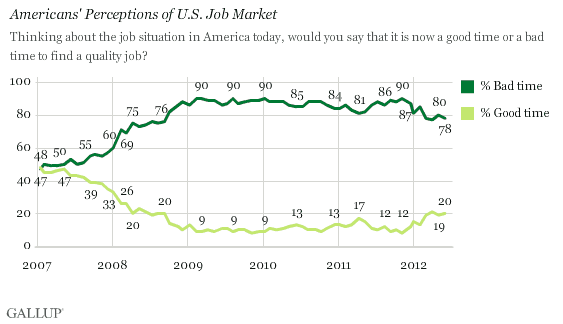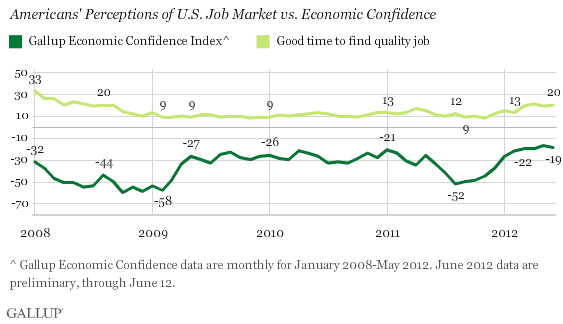PRINCETON, NJ -- Americans' perceptions of whether now is a good time or bad time to find a quality job remain flat at a weak but recently improved level, with 20% calling it a good time and 78% a bad time.

The new data are based on a June 7-10 Gallup poll conducted a week after the government's June 1 labor report that showed unemployment unexpectedly rising in May. Gallup's Economic Confidence Index declined slightly last week, perhaps as a result. The stability in public perceptions about the availability of quality jobs in this June measure thus shows there is some public resilience in the face of bad economic news. However, it may also reflect the recent Gallup finding that less than half of Americans had a negative reaction to the report.
Since March, between 19% and 21% of Americans have said it is a good time to find a quality job and between 77% and 80% have called it a bad time. By contrast, from October 2008 through February 2012 -- commencing with the start of the U.S. financial crisis -- perceptions were even more negative, with between 81% and 90% calling it a bad time to find a quality job.
Economic Confidence and Job Market Perceptions Linked
The recent improvement in the "quality job" number corresponds with a slight improvement in Americans' economic confidence over the same period. More broadly, as positive perceptions about the availability of quality jobs have increased from 9% last summer to about 20% in recent months, monthly averages for the Gallup Economic Confidence Index have increased from -52 to roughly -20.

Notably, a previous increase in economic confidence, in mid-2009, did not correspond with an increase in perceptions of the job market, suggesting that rally may have had more to do with optimism about the new presidential administration and other factors than about the job market. The latest upturn in confidence is more clearly aligned with an improving jobs picture, in terms of both an improving unemployment rate and Americans' broader perceptions of the ease of finding a quality job.
Bottom Line
Americans still hold a mostly negative view of the U.S. job market, with just one in five perceiving it's now a good time to find a quality job. However, these perceptions represent a sustained improvement compared with the long period of even more negative perceptions that took hold in late 2008 and continued through early this year. Significant reductions in the U.S. unemployment rate likely explain the improvement, and align with a broader increase in Americans' overall confidence in the economy.
Survey Methods
Results for this Gallup poll are based on telephone interviews conducted June 7-10, 2012 with a random sample of 1,004 adults, aged 18 and older, living in all 50 U.S. states and the District of Columbia.
For results based on the total sample of national adults, one can say with 95% confidence that the maximum margin of sampling error is ±4 percentage points.
Interviews are conducted with respondents on landline telephones and cellular phones, with interviews conducted in Spanish for respondents who are primarily Spanish-speaking. Each sample includes a minimum quota of 400 cell phone respondents and 600 landline respondents per 1,000 national adults, with additional minimum quotas among landline respondents by region. Landline telephone numbers are chosen at random among listed telephone numbers. Cell phone numbers are selected using random-digit-dial methods. Landline respondents are chosen at random within each household on the basis of which member had the most recent birthday.
Samples are weighted by gender, age, race, Hispanic ethnicity, education, region, adults in the household, and phone status (cell phone only/landline only/both, cell phone mostly, and having an unlisted landline number). Demographic weighting targets are based on the March 2011 Current Population Survey figures for the aged 18 and older non-institutionalized population living in U.S. telephone households. All reported margins of sampling error include the computed design effects for weighting and sample design.
In addition to sampling error, question wording and practical difficulties in conducting surveys can introduce error or bias into the findings of public opinion polls.
View methodology, full question results, and trend data.
For more details on Gallup's polling methodology, visit www.gallup.com.
